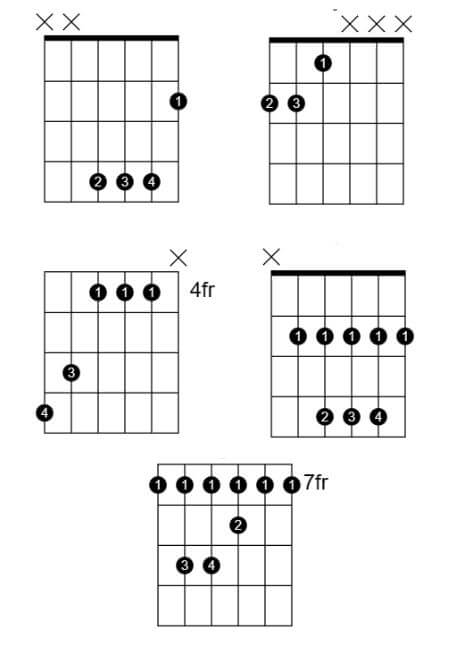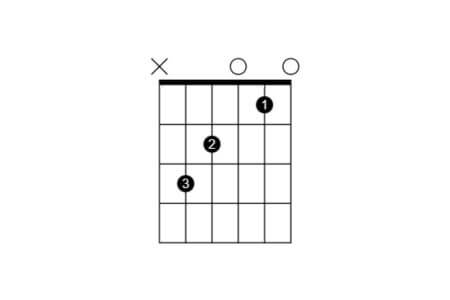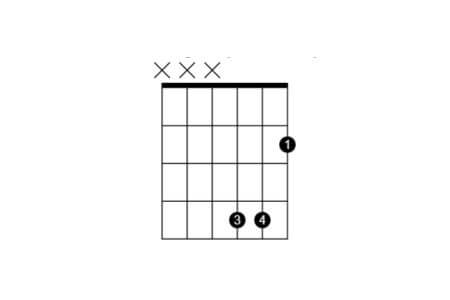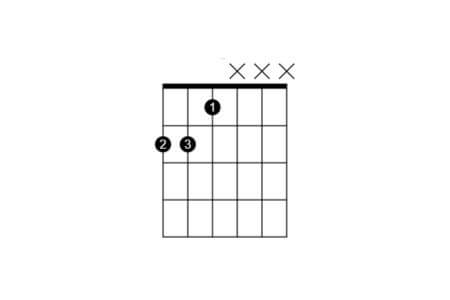5 Ways To Play The B Chord On Guitar
The B chord comes up frequently in guitar music, which makes it a great one to know. That said, it’s also not the easiest chord out there.
Like many guitarists, I used to avoid playing it most of the time. Hopefully this post will convince you not to make the same mistake. Rather, we’re going to confront the B chord head-on.
If you’re just here for a quick reference, you’ll find all five B chord shapes below:

How to Read a Chord Diagram
Chord diagrams are the easiest way to communicate how groups of notes should be fretted on the guitar. Check out the chord diagram below:

You’ll notice 6 vertical lines and 5 horizontal lines. Each vertical line represents a guitar string, while each horizontal line represents a fret. Each black dot is a note to be fretted, and the numbers within the black dotes indicate a recommended fingering.
Fingering notation is easy enough to grasp for the fretting hand: 1 = index finger, 2 = middle finger, 3 = ring finger, and 4 = pinky. Any finger number that occurs on multiple frets suggests a type of barre chord. Usually that’ll be performed by the index finger.
You might see certain X’s and O’s above the diagram. They’re not meant to haunt you, but to convey which strings should be played open (O’s) and which strings shouldn’t sound (X’s). For B Major #1 above, you either need to mute strings 5 and 6 or simply start your strum on the 4th string.
What's a B Chord?
We can think of a chord as three or more pitches heard simultaneously. When we’re talking about a B chord, we’re using a shorthand for a B major chord. Fortunately, all major chords are built the same way; this one just happens to start with B.
You build a major chord using a root note (B) and two other notes at specific intervals above the root. These intervals are a major third (which gives the major chord its name) and a perfect fifth.
You can find third intervals by counting every other note in the musical alphabet: B, D, F, A, C, etc. As you can see, D is a third above B while F is a third above D (and thus a fifth above B).
So we know that a B chord should contain the letters B, D, and F. However, what makes the B chord tricky is that it actually contains the notes B, D#, and F#. D is still a third above B, but it’s only a minor third. Raising it one half-step (or up one fret on the guitar), we get a major third.
It’s basically the same story for F; one way to think of a perfect fifth is that it contains two notes 7 half-steps apart (which is a 7 fret distance on the guitar). If you count up by half steps, you’ll realize that F# is exactly a perfect fifth above B. In fact, let’s do that count right now: B, C, C#, D, D#, E, F, F#. That’s seven half-steps up!
I know that seems like a lot of information. Let’s just say that the least you should know is that a B major chord contains the notes B, D#, and F#. Check all the above shapes against a fretboard note diagram and you’ll see they all contain at least one of each of those notes and no others.
If some of these ideas are challenging for you, I think you should head over to this helpful post. It’s about leveling up your theory game with the right books.
Why Is the B Chord Difficult on Guitar?
I think it’s a fair question, and one that isn’t easy to answer. First off, in many respects the B chord isn’t difficult at all. You can play one of the easier shapes above and get by, no problem.
Also, the standard B barre chord (shape #4 above) is actually one of the easier barre chords out there. Your index finger only needs to apply pressure to the 5th and 1st strings, as the middle three strings are fretted. I believe anyone can master this chord with a bit of practice.
But why isn’t it as easy as D, A, E, or C? I’d say the main reason has to do with the guitar’s tuning (EADGBE). Most of the “easy” chords we think of take advantage of multiple open strings. This saves the left hand some work.
Let’s consider a classic open C chord, pictured below:

The C chord contains the notes C, E, and G. You’ll notice that this shape takes advantage of the open G and high E strings, allowing you to sound five strings while fretting only three.
Unfortunately, as the notes B, D#, and F# make up a B chord, you don’t have that same open-string shortcut. Sure, you can throw in an open B string, but the truth is, D# and F# are a bit awkward on the guitar. I’d say that’s the main reason the B chord shapes are never that easy.
Common Chord Progressions
Here are some common chord progressions that involve the B chord:
B – E – F#
C#m – F# – B
E – A – B
F# – A# – B
F#m – B – E
E – B – Cm – A
The Easiest Ways to Play the B Chord
Who doesn’t want to make things easier on themselves? I can’t say I blame you. Life’s hard enough!
For me, the diagram below represents the easiest way to play the B chord:

Just take up that shape and strum down starting from the 3rd string. From lowest pitch to highest, you’re playing the notes B, D#, and F#. And no, there’s absolutely nothing wrong with a 3-string chord. Sometimes it’s best to keep things simple.
Here’s the second-easiest way to play the B chord:
-.jpg)
This shape adds the second finger above the third. You might find the two-fret separation between your index and remaining fingers uncomfortable at first; that’s completely normal.
Just keep at it and trust that your fingers will get used to the position. The notes in this shape, going from bass strings to treble strings, are F#, B, D#, and F# (one octave above the other F#).
The final easy B chord shape is as follows:

This one’s another three-string chord, but it sounds fuller due to the bass strings. If you play fingerstyle (or you’re good at muting strings) you can top this chord off with the open B string. Just be sure not to sound the G string!
Barring B Major
If these shapes look hard to you, then you probably need to work on your barre chords. The best way to do that is to practice barring regularly. You should resolve to barre for at least a few minutes every time you practice.
Before long, you won’t break into a cold sweat whenever they come up. In fact, you’ll find that they’re incredibly useful shapes.
The reason barre chords are useful is that they’re moveable up and down the fretboard. So for every single shape you memorize, you’re learning 12 or more chords.
Once you know the root note of the shape (B on the 6th string for #3 and #5, B on the 5th string for #4), you’ll be able to slide up and down the fretboard using the same exact pattern.
For instance, if you slide the the B Major #5 shape up one fret, you’ll be playing C major. Slide up another fret and you’re playing C# or Db. Slide up again and you’re playing D major on the tenth fret. Pretty cool, right?
I’ve written two other posts dedicated to conquering barre chords, both of which I highly recommend. You can find the first post right here and the second post right here. Definitely check them out if you’re struggling with barring technique.
Conclusion
The B chord isn’t the easiest guitar chord out there. Like the F chord, I’m sure most of us have avoided it at some point.
My hope is that you like at least one of these ways to play the B chord. And yet, even if you don’t, you can always find another way to fret it. That’s the beauty of the guitar grid.
Good luck in the practice room!
Are you looking to upgrade your gear or browse some awesome guitar learning materials? Check out my recommendations page to see all my favorite stuff.
Want to streamline your fingerstyle guitar progress? I just released my new ebook, Fingerstyle Fitness, which presents 10 easy exercises to quickly develop your fingerstyle chops. Grab it today!